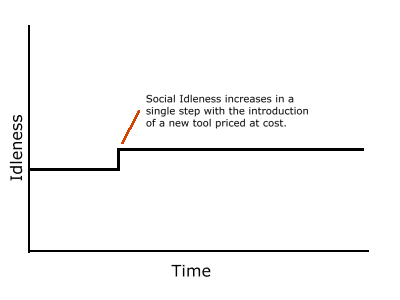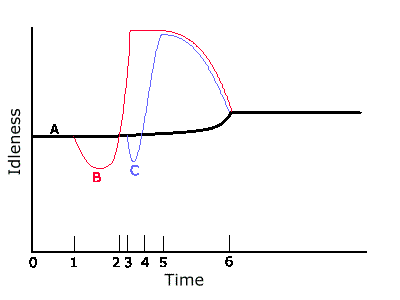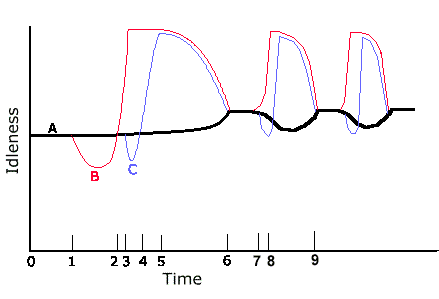
The Business Cycle.
The appearance of a useful new tool in an economy will result, given just prices (e.g. price = cost), in a rise in social idleness. Everyone in the trading system will become a bit more idle.

In practice, the appearance of a new tool is likely to be rather more complex than a simple step change in social idleness. There is no incentive, apart from altruism, for the producer of a new tool to conceive, design, and produce some new tool - and then sell it at cost. Where social idleness is indicated by A in the graph 1, and the idleness of the first producer of a new tool is indicated by B, and the idleness of subsequent competitors by C, a fairly complex process takes place.

At time 0, it is assumed, all traders in the system have equal idleness. At time 1, the producer of the new tool starts working on its design and production, and his idleness falls. At time 2, he starts selling it. At first he sells it at a modest profit, but when it sells out, he keeps on raising prices until price exceeds value, at which point discriminating users will stop buying. If the tool has one specific use, and consequently a single value, he will raise the tool price to (or to just below) its value. Selling at top price, producer B's idleness will rise to well above that of other traders. At time 3, other producers (C), noticing the appearance of the new tool, will start working to produce copies of it, and begin selling then at time 4, raising their prices to also equal tool value. For the buyers and users of the tool, the effect of buying tools whose price equals their value means that they gain as much time as they spend, and their idleness doesn't change.
If the first producer's output does not meet demand, and nor does the second producer's additional output meet demand, prices will stay high. It is only when, at time 5, sufficient producers are making sufficient tool quantities to meet or exceed demand that some tools will go unsold. In order to regain market share, these producers will then drop their prices, and a price war will ensure, with all tool producers reducing prices until, at time 6, the new tool's price has been driven down to cost. During the price war, the buyers and users of the new tool will find themselves the principal benefactors, with their idleness rising sharply.
Once prices have been driven down to costs, since price = cost results in social equality, the system will stabilize at a new, higher level of equal idleness, and the cycle is complete. Prices will only be driven down to costs if competing tool values, lifetimes, and costs are equal. If costs are different from one producer to another, falling prices will drive the higher cost producers out of the market, until supply matches demand.
While producers are unable to meet demand for the new tool, they will form a de facto cartel, maintaining high prices. They only begin to compete, reducing prices, when their combined production exceeds demand.
During the business cycle, initially the principal beneficiaries are the producers and sellers of new tools, because they can sell them at high prices. It is only later in the cycle, as competition between producers results in falling prices, are the benefits passed on to the buyers and users.
There is an assumption here, however, that at the end of the cycle, with only one or two tool producers remaining, these producers will be unable to raise prices because competitors will immediately recommence production and drive prices back down. This may be true in the immediate aftermath of a price war, but as competitors are driven out of business, and their manufacturing equipment and skills are dispersed and lost, all effective competition fades away. At that point, the remaining tool manufacturers will gain an effective monopoly, and will begin to push prices back up again. Indeed, in order to hasten this process, manufacturers may buy up the assets of bankrupt producers, simply to remove to the possibility of subsequent competition. Either way, when monopolists raise prices, in time this will attract competitors, and the cycle will repeat. And so, rather than the system stabilizing, it may oscillate between vigorous competition and monopoly.

The long term
In a growing economy, in which lots of new tools are being produced, there may not be any business cycle apparent in the entire economy, because just as one tool is ending its cycle, others will be starting theirs. And so an economy growing in idleness will always have a few rich people with incomes surplus to their needs. Inequality, in part, is a byproduct of economic growth.
The returns to producers on high-priced tools may be very large. They may not only achieve near-perfect idleness, but also have an income on top to spend lavishly on luxuries and amusements. So a period of growth is likely to produce businesses that sell luxuries, toys, games, etc, simply because producers find themselves with money to burn, over and above the necessities of life. Hence, at the end of the cycle, luxury products cease to find buyers. This is not to say that luxuries and amusements must entirely vanish when, for whatever reason, new tools cease to be produced, and the economy ceases to grow in idleness: it is perfectly possible for relatively idle people, without surplus income, to use their idle time to make and sell amusements to one another.
During periods of growth, it is likely that producers will try to maintain tool prices as high as possible for as long as possible. They may be awarded patents, to prevent their tools being copied. And if they acquire enough financial muscle, they may be able to buy up or otherwise drive competitors out of business, and thus retain a monopoly on price-fixing. And even where they fail to gain a monopoly, they may organize overt or covert cartels to maintain high prices. Or else they may demand trade barriers - e.g. slapping tariffs on imported goods -, or corporate welfare in the form of subsidies, to give themselves an artificial advantage.
During periods of innovation - so-called 'booms' -, the economy produces rich people, who buy lots of luxuries, and keep everybody pretty much as busy as they were beforehand. During the boom, the idleness gained from the new technologies goes into the pockets of their producers as money to spend on luxuries. In the subsequent 'busts', the new rich lose out as their profit margins are eroded, and luxuries tend to vanish - but the overall idleness of society increases. And as the economy becomes ever more idle, and approaches perfect idleness, the booms get shorter and shallower, and the busts longer and deeper.
Ideally, in an egalitarian society, the innovation of new tools would result in a general increase in social idleness. Everybody would work, but they would work less and less as social idleness increased, less work needed to be done. But in practice, increasing social idleness results not so much in everybody doing less work, but instead fewer and fewer people doing the required work - and thus usually having incomes in excess of need -, with the rest doing no work at all, and consequently having no income at all.
In part, work cannot be shared because what work that needs to be done is of an increasingly specialized nature, and only a minority can perform it. But also it is because, as less and less work needs to be done, there is a tendency - certainly in the absence of a welfare safety net - for people to offer, or employers to demand, they work at lower wages, for longer hours, and in worse conditions - rather than have no work, no income, and no food or shelter. People don't want work, or even money: they want food and shelter.
But also there is yet another reason why society should become divided into workers and non-workers. And this is that if, in a society of 1000 people, it requires only one individual to work to sustain all 1000 people, it is more efficient for one person to do the work, rather than that small amount of work to be multiplied equally among 1000 people.
Unable to find work in an economy whose inherent purpose is to minimize work, non-workers must mostly subsist on charity, or on institutionalised 'of right' welfare, funded by redistributive taxes on the working minority - without which society would disintegrate in looting, riot, arson, and murder. For without charity or welfare, such individuals must rob and loot, simply to survive. Social welfare is, in many senses, not so much generous and open-handed charity, but more a necessary tribute society pays to protect itself from pillage and destruction. And the higher social idleness rises, and the larger the numbers of non-workers becomes, so the larger the tribute becomes, and the greater the threat of riot and mayhem if it is not paid.
At some point, perhaps as the numbers on welfare become a majority, the stigma of living on tax-funded welfare will vanish, and instead the dwindling numbers of taxed full-time workers will become a despised, albeit needed, minority. And in the same inversion of values, booms will come to be regarded as busts - because they set people to work -, and busts will be seen as booms - because they free people from work again.
Thus in extremely idle societies, the likelihood is that a very small number of people will work continuously, while the rest of society remains idle. In an inversion of the situation in antiquity, when large numbers of toiling slaves sustained a minority of idle slave-owners, now a small number of slaves will sustain an idle majority. But rather than be flogged and kept in chains, these slaves will be richly rewarded and highly praised, and perhaps acquire something of the character of a sacred priesthood.
And in the most extreme circumstance, only a single individual, in a sumptuous palace, will periodically be required to throw some switch, or check some instrument, or perform some obscure act. And if he should forget, or sleep late, an entire civilization would collapse...
Two meanings of competition
"Competition" within an economy is not regarded as the same as any sort of "competition" in the natural world. Economic competition is largely benign, in that it results in the lowest prices and the best value - which benefits everybody. By contrast, "competition" in the natural world - at least in the Darwinian vision of the natural world - results in winners and losers, and corresponds to "cut-throat competition" within an economy such that competitors are driven out of business by fair means or foul in order to secure a monopoly and maintain high prices - which benefits only the monopoly holders.
